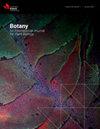Understanding bud rot development, caused by Botrytis cinerea, on cannabis (Cannabis sativa L.) plants grown under greenhouse conditions
IF 1.3
4区 生物学
Q3 PLANT SCIENCES
引用次数: 2
Abstract
Botrytis cinerea is a widespread necrotrophic plant pathogen that causes diseases on >1000 plant species, including vegetables and ornamental greenhouse crops. On cannabis ( Cannabis sativ a L.), the pathogen is responsible for causing “bud rot”, a major disease affecting the inflorescences (compound flowers), as well as seedling damping-off and leaf blight under certain conditions. During greenhouse cultivation, Botrytis cinerea can destroy cannabis inflorescences rapidly under optimal relative humidity conditions (>70%) and moderate temperatures (17–24 °C). Little is currently known about the host–pathogen interactions of Botrytis cinerea on cannabis. Information gleaned from other hosts can provide valuable insights for comparative purposes to understand disease development, epidemiology, and pathogenicity of Botrytis cinerea on cannabis crops. This review describes the pathogenesis and host responses to Botrytis infection and assesses potential mechanisms involved in disease resistance. The effects of microclimatic and other environmental conditions on disease development, strategies for early disease detection using prediction models, and the application of biological control agents that can prevent Botrytis cinerea development on cannabis are discussed. Other potential disease management approaches to reduce the impact of Botrytis bud rot are also reviewed. Numerous opportunities for conducting additional research to better understand the cannabis– Botrytis cinerea interaction are identified.了解在温室条件下种植的大麻(cannabis sativa L.)植物上由灰葡萄孢菌(Botrytis cinerea)引起的芽腐病发育
灰霉病菌是一种广泛存在的坏死性植物病原体,可引起包括蔬菜和观赏温室作物在内的近1000种植物的疾病。在大麻(大麻sativ a L.)上,病原体负责引起“芽腐病”,这是一种影响花序(复合花)的主要疾病,在某些条件下还会导致幼苗枯萎和叶枯病。在大棚栽培过程中,在适宜的相对湿度条件下(约70%)和适宜的温度条件下(17-24℃),灰葡萄孢菌可以迅速破坏大麻的花序。目前对大麻上灰霉病菌的宿主-病原体相互作用知之甚少。从其他宿主收集的信息可以为比较目的提供有价值的见解,以了解大麻作物上葡萄孢菌的疾病发展,流行病学和致病性。本文综述了葡萄孢菌的发病机制和宿主对葡萄孢菌感染的反应,并对其抗病机制进行了评估。讨论了小气候和其他环境条件对疾病发展的影响,利用预测模型进行早期疾病检测的策略,以及可以防止灰葡萄孢菌在大麻上发展的生物防治剂的应用。其他潜在的疾病管理方法,以减少芽腐病的影响也进行了综述。许多机会进行额外的研究,以更好地了解大麻-葡萄孢菌的相互作用被确定。
本文章由计算机程序翻译,如有差异,请以英文原文为准。
求助全文
约1分钟内获得全文
求助全文
来源期刊

Botany
生物-植物科学
CiteScore
2.20
自引率
9.10%
发文量
48
期刊介绍:
Botany features comprehensive research articles and notes in all segments of plant sciences, including cell and molecular biology, ecology, mycology and plant-microbe interactions, phycology, physiology and biochemistry, structure and development, genetics, systematics, and phytogeography. It also publishes methods, commentary, and review articles on topics of current interest, contributed by internationally recognized scientists.
 求助内容:
求助内容: 应助结果提醒方式:
应助结果提醒方式:


